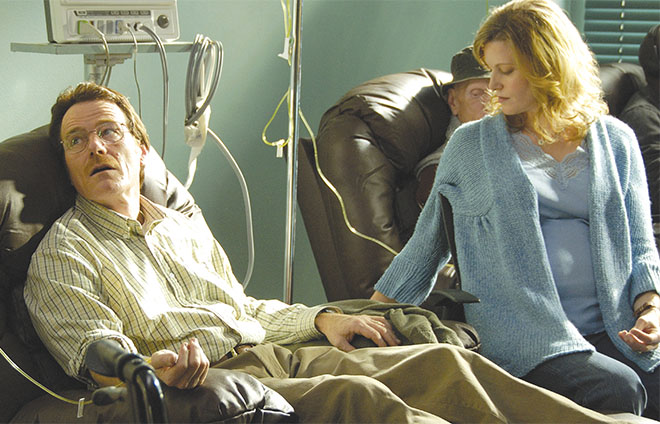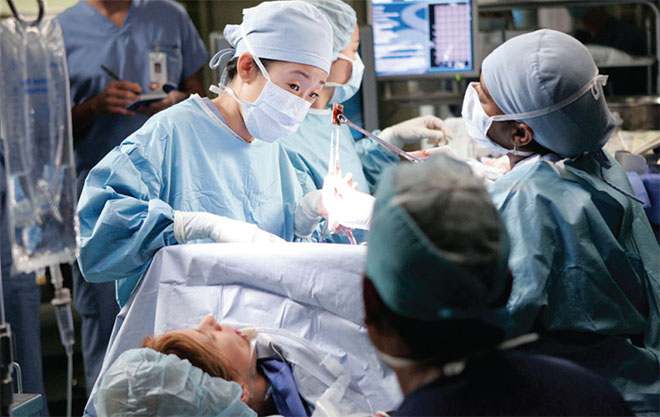TV dramas have always had a strained relationship with verisimilitude. In real life, intelligence agents don’t find themselves with 24 hours to save the world. Guns don’t carry unlimited ammunition. Computers don’t hack themselves. Still, Barack Obama likes to watch Homeland, even if he knows that a sitting U.S. congressman would find it tough to take a day or two off to carry out operations for al-Qaeda. Most of us are willing to suspend disbelief for a good story.
Sometimes, though, implausibility strikes too hard. Prosecutors complain of the “CSI effect”: Real juries expect real investigators to display CSI-level wizardry, demanding that impossibly good forensic evidence be presented in court. Human rights organizations have decried the glamorized and effective deployment of torture on 24.
When it comes to medical dramas, the fiights of fancy can have particularly dire consequences. For instance, studies show that when TV doctors perform CPR, they succeed more than half of the time. In reality, CPR succeeds in about only one of 10 instances, and long-term success, with the patient surviving more than a month, is even rarer. Yet people often ask doctors to perform CPR on their loved ones, despite certain suffering and, with elderly patients, almost certain failure. Implausible shows can influence the life-and-death decisions that people make in the real world.
So what’s a concerned public-health professional to do in response? Complaining to Hollywood doesn’t help. Neither does pleading. Any approach that’s going to work has to recognize two realities of the entertainment business. The first is that, no matter how outrageous the plot, the appearance of authenticity is valued, especially in an age of much-lauded shows like Mad Men and The Wire. “It’s very, very important for us to have accuracy,” says Sarah Watson, writer and co-executive producer for the NBC show Parenthood. The second is that writers work under pressure, up against deadlines and ravenous for any help they can get.
“It’s easier to get people to want to do things differently if you make them laugh, if you reach their emotions, if you surprise them,” Keyser says, “than if you just lecture them.”
Hence the existence of an organization called Hollywood, Health & Society. It began in 2001 as a partnership between the Norman Lear Center at University of Southern California’s Annenberg School and the Centers for Disease Control and Prevention (CDC), and its operating principle is to set expectations very, very low. Don’t seek placement for some pet message. In fact, don’t explicitly seek anything at all. Instead, offer no-strings-attached resources—in the form of specially tailored information—to help writers, directors, and producers make their shows and films.
If a TV exec needs a brie!ng on any health-related issue—from traumatic brain injury or toxic mold to antibiotic resistance or Obamacare—then she need only pick up the phone and call HH&S. On short notice, HH&S will bring a group of experts to the writers’ room. With a little more planning, HH&S will take writers on a field trip to learn about how health is affected by gang violence, for example, or by climate change. It will assemble doctors for briefings about real-world cases and protocols. It will do all this without asking for any credit, compensation, or data in return.
The intended result of all this generosity: that Hollywood’s implicit messages about health will become a little less preposterous—maybe even, on a good day, helpful. HH&S hopes that if Hollywood writers feel wholly uncoerced, secure in their knowledge that they’re tapping free resources that make their work feel more authentic, then they will effortlessly disseminate useful health information, much as a bluebird might eat a blackberry and excrete its seeds over far-flung turf.
As the organization’s founder and principal investigator, Martin Kaplan, explains, “I wanted not to be on the outside of the industry, asking the industry to do something; I wanted to be inside the industry, as a partner to it.”

(Photo: Cathy Kanavy/AMC)
And HH&S has mastered that role. According to the organization, HH&S has collaborated with writers, directors, and producers from Homeland, The Good Wife, Revenge, In Treatment, The Wire, Mad Men, and more than a hundred other shows, becoming known as a resource rather than a nuisance. “Breaking Bad? We met with them early on when they were first developing the show and getting the cancer story line straight,” boasts HH&S program director Kate Folb. “And they were nobodies in this town!”
Watson and her team at Parenthood take full advantage of HH&S’s services. “I will literally have first drafts of scripts that will have lines like ‘cancer jargon, cancer jargon, cancer jargon,’” Watson says, “and then we’ll go back to HH&S and fill it in. It makes a huge difference.”
As handy as this arrangement is for writers, it requires some forbearance on the part of HH&S. Few of Hollywood’s health-related story lines revolve around medical problems of broad public-health significance. Certainly, viewers may appreciate learning—as many did from Grey’s Anatomy, season 2—about the public-health peril of two people being impaled on one pole, but most health officials view this hazard as secondary to skin cancer and obesity. Even Grey’s writer and producer Zoanne Clack, co-chair of the HH&S advisory board, acknowledges that the show seeks out the “one-in-a-million cases.” Still, HH&S knows better than to complain. When Clack needed accurate information for a Grey’s episode about a face-transplant surgery (to be performed on a young man nicknamed “Blowhole”), HH&S dutifully came through. It connected Clack with Maria Siemionow, the lead surgeon on the first face transplant in the United States.
Grey’s Anatomy isn’t alone in preferring outlandish scenarios to ones that revolve around, say, reduced salt intake. Accord- ing to a 2008 study (on which HH&S collaborated) of the top 10 primetime shows from the previous few years, story lines featuring rare illnesses appeared more than four times as often as those featuring heart disease; five times as often as those featuring cancer; and 24 times as often as those featuring diabetes.
“I will literally have first drafts of scripts that will have lines like ‘cancer jargon cancer jargon cancer jargon,’ and then we’ll go back to HH&S and fill it in.”
Still, HH&S accepts the mild indignity of fielding a stream of phone calls about things like finding oneself encased in cement, because even a tiny bit of messaging, the organization believes, goes a long way. “You get a big bang for your buck by having an accurate story line on a popular show,” says program director Folb. And while research on the topic of public-health messaging is still limited, nearly all of it suggests that Folb is right. When it comes to changing people’s health-related beliefs and decisions, storytelling is uniquely persuasive.
Psychologists are still debating why stories work better than straight messaging. Between 2010 and 2012, Sheila T. Murphy, a researcher at USC Annenberg, worked with a group of communications scholars, filmmakers, and medical experts to make two short films conveying the same facts: that the human papillomavirus (HPV) causes cervical cancer, and that a Pap test can help prevent and detect that cancer. The first film was non-narrative: It involved doctors and evidence and charts. The other was a narrative film, involving a family whose plans for a quinceañera are disrupted when a daughter gets an abnormal Pap test result. When 758 women were shown one film or the other, those who watched the narrative movie learned more and changed their attitudes more dramatically than those who watched the non-narrative film.
One argument as to why the quinceañera film worked best is that when people interact with narrative they bond with the characters, forming something like friendships. They get wrapped up in “parasocial interactions,” one-way relationships with the people on the screen. And these interactions make them less likely to feel defensive about embedded messages.
Another theory—this one less scientific—is advanced by the writer Christopher Keyser, president of the Writers Guild of America, West, who co-created the series Party of Five and co-chairs the HH&S advisory board. “It’s easier to get people to want to change their behavior if you make them laugh, if you reach their emotions, if you surprise them,” Keyser says, “than if you just lecture them.”

HEALTHILY ACCURATE: The group Hollywood, Health & Society helped Breaking Bad screenwriters to get the details of cancer treatment right, and it has regularly provided advice to Grey’s Anatomy. (Photo: ABC)
This may be why the CDC isn’t the only organization putting up money for HH&S. Other federal agencies, including the National Cancer Institute and the Office of National Drug Control Policy, have also provided funds. So have several major foundations, including the Bill & Melinda Gates Foundation and the California Endowment.
Not everyone agrees that this is money well spent. In a 2007 U.S. Senate subcommittee report, a section on the CDC’s funding of HH&S suggested that television producers “have an incentive, without federal taxpayer involvement, to get their story lines correct.” But CDC officials seem to think the investment is worth it. “Because 88 percent of Americans learn about health issues from television,” says CDC public affairs director Barbara Reynolds, “[the] CDC recognizes that primetime and daytime television programming are rich and productive channels for disseminating public-health messages.”
Clack, who is Grey’s Anatomy’s resident physician-writer, also believes the investment is working. Medical shows, she says, have become markedly more accurate over the past two decades.
And when it comes to messaging, Grey’s itself, at the very least, has occasionally granted HH&S a full-fledged touchdown. This has been the case with a Grey’s character named Braden, a 10-year-old with Severe Combined Immunodeficiency. Braden’s immune system is so compromised that he is condemned to live behind plastic barricades. His only hope for escape is a bone marrow transplant, but prospects for finding a donor are bleak. The problem: His parents are African American and mixed-race, and for the operation to work he’ll need a donor of similar ethnic background. “After all these years working with HH&S, I really wanted to get in there that minority donors are hard to find because they don’t donate as much,” Clack explains. “It’s one of the great things when the story and the message can merge.”
There’s still room for the message to go wrong, of course. The story line only began airing in April, and it’s still unfolding. Maybe Braden will find himself cured by a gluten-free diet; maybe he’ll take Dr. Bailey hostage and die in a bloody shootout. None of this would particularly please HH&S. But if Braden’s dilemma creates even a modestly better-informed public, then Hollywood, Health & Society will have scored a win. And then its staffers will go back to taking phone calls about conducting heart surgery in a stalled elevator.
This post originally appeared in the July/August 2014 print issue ofPacific Standardas “Can You Spot the Health Propaganda?” Subscribe to our bimonthly magazine for more coverage of the science of society.





